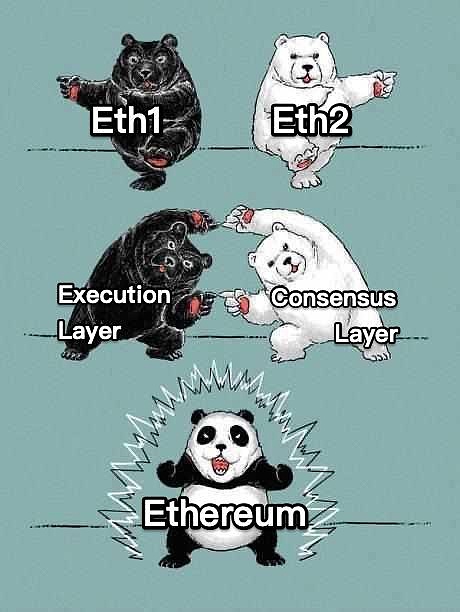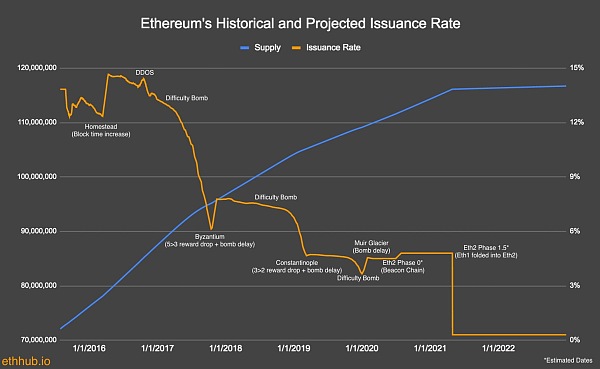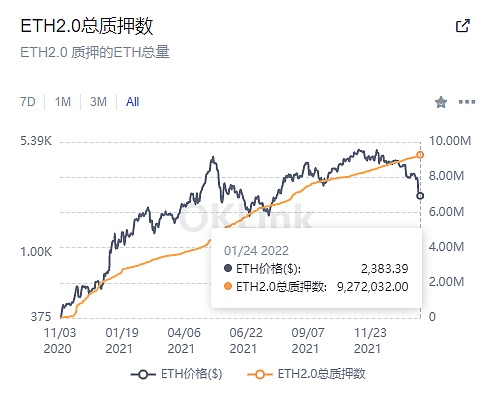As we all know, Ethereum is a blockchain network undergoing important changes.
In recent years, there has been unprecedented growth in decentralized applications (Dapps) and other forms of blockchain technology, many of which are built on top of Ethereum. Much of the major innovation in decentralized finance (DeFi) is running on Ethereum.
The surge in demand for the use of the Ethereum network has exposed scalability issues, making Ethereum's transaction fees expensive. However, if Ethereum wants to become a platform leading the development of Web3, it must comply with economic principles, otherwise it has no practical significance.
"Ethereum 2.0" thus came into being. The "Ethereum 2.0" upgrade proposal focuses on addressing scalability issues. On the premise of ensuring security and decentralization, through the implementation of various technical upgrades, the entire "consensus upgrade" is realized, and the transition from the workload proof mechanism (PoW) to the equity proof mechanism (PoS), the speed and efficiency of the Ethereum network And scalability will be significantly improved.
in short:
in short:
Eth1 → Execution layer: responsible for processing transactions and data
Eth2 → Consensus layer: responsible for handling PoS consensus
Execution Layer + Consensus Layer = Ethereum
With "Eth1" and "Eth2" merged into one chain, there will no longer be two distinct networks; there will only be one full Ethereum.
first level title
Why the renaming?
user misunderstanding
accuracy
accuracy
With the continuous advancement of the Ethereum upgrade roadmap, "Ethereum 2.0" has become an inaccurate expression. Careful and precise choice of terminology allows the broadest audience to understand what is on Ethereum.
fraud prevention
Some malicious actors have tried to use "Eth2" to trick users into telling them that they can swap their ETH for "ETH2" tokens, or that they must somehow migrate their ETH before the Eth2 upgrade.
consistency
consistency
The Ethereum Foundation wants to encourage users to move away from outdated terminology. By changing the name, we will help create consistency and clarity across the ecosystem and make Ethereum more accessible.
Improving clarity on pledges
first level title

How is the upgrade going?
It is not accurate to imagine "Ethereum 2.0" as a separate blockchain, but can be seen as consisting of "a set of upgrades", which include the creation of a new chain called "beacon chain" and sharding. Shards can include as many as 64 chains, and the mainnet will "merge" with these parallel systems. Simply speaking, it is divided into three stages, namely, beacon chain, merger and fragmentation. Although the technical upgrades involved in each stage are developing in parallel, the current order is beacon chain → merge → sharding.
Beacon chain (already live)
The PoS beacon chain, previously widely known as Phase 0 of "Ethereum 2.0", went live in December 2020. The beacon chain is designed to manage or coordinate extended sharding and PoS network staking, where Ethereum users can lock their ETH in smart contracts to help secure the network. In exchange, they will receive income from staking.
Consolidation (expected 2022)
Initially, the beacon chain will run separately from the current mainnet. While the Beacon Chain runs in parallel using a PoS consensus mechanism, the current Ethereum mainnet continues to be secured through a PoW consensus mechanism.
Merging is the eventual fusion of these two systems. When ready, the Ethereum mainnet will be "merged" with the Beacon Chain, which will introduce the ability to run smart contracts along with the full history and current state into the PoS system.
This will mark the end of the Ethereum PoW consensus mechanism and usher in a more sustainable and environmentally friendly era. At this point, Ethereum will be closer to achieving the comprehensiveness, security, and sustainability described in its vision. Once the merger happens, it will be up to stakers to validate the Ethereum mainnet. GPU mining is no longer required, and previous miners may be invested in the new PoS system.
According to an information session hosted by ConsenSys, three researchers working on the merged technology believe that merging the Ethereum mainnet with the PoS beacon chain will reduce network energy usage by at least 99.95%.
In addition, the merger will alleviate:
The PoW consensus mechanism is not sustainable and cannot scale in the long term.
The PoS consensus mechanism makes it easier for more users to participate in the network, not just large miners.
It is worth noting that once the merger is completed, there may be a "triple halving" situation. "Triple Halving" named for the community is a tribute to the "halving" of Bitcoin output, which means that once the merger occurs and Ethereum is fully upgraded to PoS, ETH issuance will drop significantly. Under the current PoW model, Ethereum issues about 13,500 ETH per day - an annual issuance of about 4.3% of the total ETH supply chain. However, the PoS model is based on the amount of ETH actively staked on the network. According to forecasts, when the "consolidation" occurs, the issuance rate will drop significantly. When the "triple halving" is combined with EIP-1559's burn mechanism, it is expected that Ethereum's issuance will actually become deflationary during user activity.
Even though the issuance rate of ETH is reduced and block rewards are reduced, more users will benefit from a more equal distribution of network rewards.

Sharding (expected 2023)
The original plan was to handle sharding before merging - to address scalability issues. However, as layer 2 scaling solutions (Layer 2) flourished, developers shifted their priorities to merging, so sharding needed to be continually evaluated against Ethereum's subsequent development. Given the Rollups-centric roadmap, the urgency of shard chains is debatable.
Sharding is a common concept in computer science - the process of splitting a database horizontally to spread the load. In Ethereum, sharding will reduce network congestion and increase transactions per second by creating new chains called "shards".
Overall, sharding is a better scaling solution than simply increasing the size of an existing database, which would require validators to upgrade to more powerful and expensive computers. With a shard chain, validators only need to store data for the shard they are validating, not the entire network. This speeds up the Ethereum network and greatly reduces hardware requirements.
first level title
Will the merger happen this year?
In the more than a year since the beacon chain went live, "Ethereum 2.0" has indeed made some progress, and developers have taken a big step towards the final version of Ethereum.
Although for individual verifiers, the minimum threshold for participating in the pledge is 32 ETH, the lock-up time is too long and cannot be redeemed in the short term, which is a relatively big disadvantage. However, the staking services provided by some encrypted exchanges and the popular "ETH Liquidity Staking" project in recent months have changed the situation. The number of ETH pledged on the beacon chain reached about 9.27 million pieces, accounting for 9.27 million pieces of Ethereum supply. 7.88% of the total amount, more than 17 times more than the original target, and an increase of about 3 times compared with the same period last year. The number of verification nodes on the beacon chain has exceeded 280,000. (The data chart comes from OKLink)

As we move into 2022, according to the schedule, we may see the merger of the execution layer (ETH1) and the consensus layer (ETH2) this year, as well as the post-merger cleanup work. ETH. These details will be updated separately shortly after the merge.
In December last year, Tim Beiko, the core developer of Ethereum, announced the launch of the merger testnet (long-term) Kintsugi, whose main purpose is to familiarize the community and project developers with the post-merger environment of Ethereum. Connecting to the testnet is easy, the MetaMask wallet can select the Kintsugi testnet directly from the list of networks. The testnet has a mock funding faucet feature where users can try out transactions with 50 ETH. For those not using MetaMask, there are several other options for connecting to the testnet.
According to official documents, if the test is stable, then the next step is the transition of the Ethereum mainnet to PoS, that is, the merger of the beacon chain and the mainnet.
In the same month, Superphiz, a security consultant in the Ethereum Beacon Chain community, stated on personal social media that the Ethereum fork Bellatrix (formerly known as The Merge) will activate the current main network and the Beacon Chain merge, but will not immediately enable pledge on the Beacon Chain The redemption mechanism of ETH is expected to open the redemption of pledged ETH about 6 months after the merger. And he expects that Bellatrix will be implemented in June 2022, so the redemption of ETH pledged by the open beacon chain will be in December.
Driven by many reasons, "Ethereum 2.0" will become an important upgrade of the Ethereum network, and the encryption industry regards it as the key to solve the scalability problem. Without the support of new features such as PoS, shard chain, and beacon chain, Ethereum will eventually be unsustainable and lose its leading position as a smart contract platform in the encryption ecosystem.
According to the "Notice on Further Preventing and Dealing with the Risk of Hype in Virtual Currency Transactions" issued by the central bank and other departments, the content of this article is only for information sharing, and does not promote or endorse any operation and investment behavior. Participate in any illegal financial practice.
risk warning:
According to the "Notice on Further Preventing and Dealing with the Risk of Hype in Virtual Currency Transactions" issued by the central bank and other departments, the content of this article is only for information sharing, and does not promote or endorse any operation and investment behavior. Participate in any illegal financial practice.



